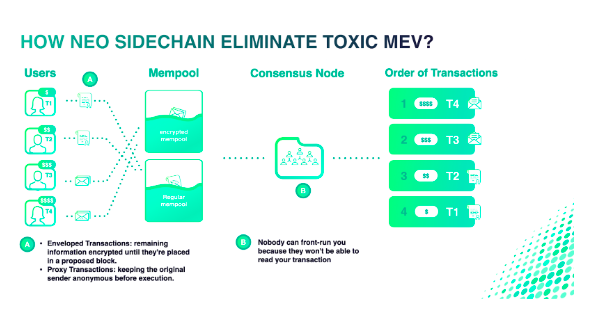Analyzing Neo Sidechains: Using dBFT+ Sealed Transactions to Resist Malicious MEV
Two months into 2024, the cryptocurrency market is showing an upward trend. Many mainstream cryptocurrencies, led by Bitcoin and Ethereum, have seen continuous price increases, with Bitcoin reaching $52,000 during the Spring Festival and Ethereum briefly breaking the $3,000 mark, both getting closer to their historical highs.
A few days ago, the Uniswap Foundation released a new proposal to allocate protocol fees to staked UNI token holders, igniting the DeFi market. Not only did the DeFi leaders experience a surge, but other DeFi projects like Frax Finance also mentioned considering introducing a similar token staking reward mechanism as Uniswap.
According to data from the data provider DeFi Llama, the total value locked (TVL) in DeFi-focused blockchains has grown by about 40% since last November, reaching approximately $60 billion, marking the highest level since August 2022. The prospects for the DeFi market in the summer of 2024 are promising. In the context of the booming DeFi market, it has become crucial to build a fair and secure environment for users.
Retail Investors in DeFi Have Long Suffered from MEV
For on-chain users, especially retail investors in DeFi who often find themselves sandwiched, MEV has become a well-known concept. MEV stands for Maximal Extractable Value, referring to the maximum profit that miners or validators can extract by reordering transactions within the same block in the mempool.
There are several types of MEV, the most common being front-running, back-running, and sandwich attacks. Front-running refers to MEV arbitrageurs leveraging their predictions of price changes to buy or sell ahead of other transactions in the mempool, profiting from the price changes. Back-running is the opposite, where MEV arbitrageurs place their transactions after known transactions to profit. A sandwich attack involves MEV arbitrageurs executing buy and sell activities around a large upcoming transaction to profit from the price movements.
MEV can serve many purposes, some of which are neutral transactions, such as DEX arbitrage providing better liquidity for long-tail markets or improving the liquidation efficiency of lending protocols. However, most front-running and sandwich attacks are initiated by malicious MEV bots known as Searchers, who examine user transaction content, detect additional value, then reorder transactions and pay high fees to validators to ensure their inclusion in a block, constituting malicious MEV attacks.
Neutral MEV is an effective profit mechanism, and neutral MEV activities form an established market mechanism for profit through price differences in the DeFi ecosystem, constituting a significant portion of market activity. However, malicious MEV profits often come at the expense of ordinary users' interests and network performance, significantly impacting the entire DeFi ecosystem.
It is estimated that malicious MEV on the Ethereum chain alone generated approximately $400 million in total revenue in 2022. Based on this, it can be reasonably estimated that by September 2022, at the time of Ethereum's merge, the historical cumulative revenue from malicious MEV could reach around $900 million to $1 billion.
The high-frequency, concentrated on-chain activities brought by MEV bots raise GAS fees and cause network congestion.
MEV activities are generally initiated by a small number of miners and validators, leaving most users unable to participate, which brings significant centralization risks to the network. This contradicts the original intention of blockchain networks to be decentralized, fair, and have low participation thresholds.
Anti-MEV Solutions Often Come at the Cost of Efficiency
It is evident that promoting neutral MEV innovations and preventing malicious MEV is currently the optimal strategy against MEV behavior. There are mainly two approaches to prevent malicious MEV:
1. Building MEV-specific channels for arbitrageurs
Flashbots has been providing MEV-related tools for arbitrageurs on Ethereum. Currently, the most discussed tool is MEV Boost, launched for the PoS mechanism. Ultimately, these tools provide arbitrageurs with an independent communication channel with validators, thereby reducing the impact of arbitrageurs obtaining MEV on ordinary users and network performance.
2. Providing MEV protection for ordinary users
As users discover that their interactions are often sandwiched, the ability to resist the damage from malicious MEV has become a consideration when choosing dApps. More and more DeFi projects and developers are beginning to improve their anti-MEV measures. User-facing anti-MEV features are generally implemented in two ways:
Off-chain order matching. Many DEXs, including 1inch, Matcha, and Cowswap, have introduced some form of off-chain order matching mechanism to reduce arbitrageurs' opportunities to obtain MEV. However, this mechanism may lead to greater slippage and transaction delays in low liquidity environments and introduces centralization risks.
Exclusive trading channels. MEV Protect launched by Flashbots, along with some DEXs' exclusive trading services, helps users establish dedicated trading channels, similar to private RPCs. Users can pay higher GAS fees to send their transactions directly to validators without going through the mempool.
It is not difficult to see that there is currently no embedded native MEV solution on the Ethereum network. Ordinary users who want to avoid front-running and sandwich attacks must rely on third-party tools and services. First, they need to conduct research to find suitable products or install plugins. On the other hand, using these services often means high fees and low transaction efficiency. This remains too high a barrier for most occasional DeFi users, with low cost-effectiveness.
Recently, Neo announced the upcoming launch of a native anti-MEV sidechain. If the Neo sidechain truly possesses the attributes to achieve native anti-MEV, it could be a choice more aligned with the original spirit of fairness and decentralization in blockchain for DeFi projects and the vast majority of ordinary users.
Neo Sidechain: Combating Malicious MEV with dBFT and Sealed Transactions
Although Neo's sidechain is also an EVM chain, it has a significant difference compared to Ethereum and other EVM chains: it is not PoS but dBFT. Since its inception, Neo has adhered to the dBFT consensus mechanism, and previous announcements have confirmed that the new sidechain will also continue to use dBFT. On this basis, the Neo sidechain introduces a new type of transaction—sealed transactions, which remain encrypted until a new block is proposed. This means that no one can see these transactions before they are executed, preventing anyone from preemptively understanding transaction intentions, thus eliminating the possibility of arbitrage.
These two key foundational features give the Neo sidechain the capability to resist malicious MEV at the protocol level. Developers can directly integrate this native feature into their dApps, something that other chains currently cannot offer. For users, there is no need for complex reading comprehension and cost estimation regarding different tools and products; ordinary users can receive protection against malicious MEV without being aware of it.
How Neo Sidechain Achieves Native Anti-MEV
For those interested in understanding the technical features of Neo sidechain's anti-MEV capabilities, I have organized the information currently available from official announcements and media reports, TLDR:
1. dBFT Consensus Mechanism
Neo sidechain will continue to use the dBFT (Delegated Byzantine Fault Tolerance) consensus mechanism, which has inherent advantages in preventing time bandit and block withholding MEV attacks compared to PoS chains.
Once a block is generated, the Neo sidechain can immediately confirm the block, preventing attackers from rearranging submitted transaction sequences.
The behavior of consensus nodes is monitored by the community, and withholding block time for too long will result in penalties, ensuring the fairness and security of the system.
2. Sealed Transactions
The Neo sidechain introduces sealed transactions, allowing transactions to remain encrypted until a new block is proposed.
No one can see the transaction content before execution, preventing the leakage of pre-transaction intentions and effectively guarding against arbitrage behavior.
Users can send transactions through proxies, maintaining the anonymity of transaction initiators before execution.
3. Threshold Decryption and Distributed Key Generation (DKG)
During sealed transactions, the Neo sidechain uses "threshold decryption" tools and sets the keys for threshold decryption through "distributed key generation."
Consensus nodes only hold a portion of the private keys, while all nodes collectively own a public key.
This mechanism ensures transaction privacy and guarantees that complete transaction data can only be safely reconstructed when a sufficient number of nodes participate in cooperation (2/3 of nodes must reach consensus for dbFT consensus).
4. Separation of Anti-MEV Transactions from Ordinary Transactions
The Neo sidechain has a dedicated mempool for storing anti-MEV transactions, separate from ordinary transactions, ensuring that anti-MEV transactions do not affect normal transactions.
In each block, ordinary transactions are always placed after anti-malicious MEV transactions, and encrypted transaction senders can still set a certain priority fee without worrying about their transactions being replaced by others.
The mempool has additional checks to minimize the impact of potential issues on all-chain transactions (e.g., DoS attacks or decryption failures of outdated anti-MEV transactions, etc.).

Overall, the Neo mainchain has been updated to the third generation, and its ecosystem has remained lukewarm. By being EVM-compatible, Neo aims to attract more EVM ecosystem applications and users to its sidechain. As a long-standing public chain that has weathered market fluctuations, it possesses a certain level of appeal and influence. On the other hand, with the unique advantages of dBFT and sealed transactions, users can achieve a secure and private trading environment at a lower cost, without the constant worry of being sandwiched in transactions.
If these design expectations can be realized, the Neo sidechain may become a more equitable and retail-friendly EVM ecosystem, bringing a wave of fresh blood to the entire ecosystem and community. Additionally, the interactive airdrop accompanying the testnet launch is also worth looking forward to.









